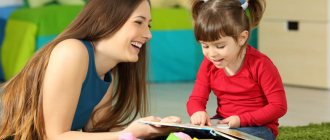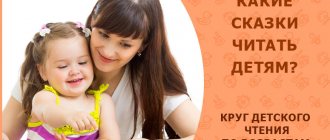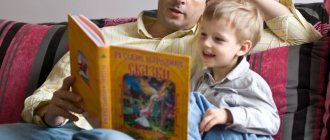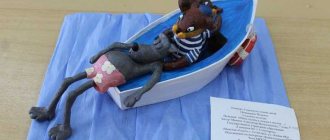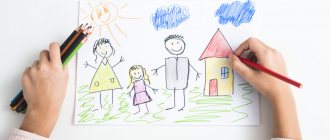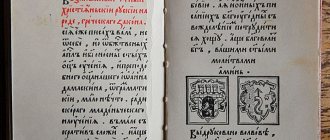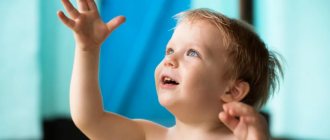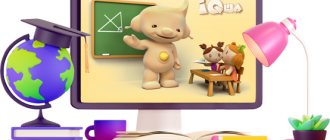At different ages, children love to listen and watch different fairy tales. Kids prefer short stories from picture books that help them better understand the meaning. Children 3-4 years old are happy to choose longer fairy tales, with different characters. Older preschoolers prefer adventures and unusual heroes.
Sometimes children refuse to listen to fairy tales and say: “I’m not interested!” Perhaps you simply chose a fairy tale that is not appropriate for your age. On our website you will learn how to choose the right story to read before bed and you will find a whole online selection of fairy tales for children 3-4 years old and other ages.
Fairy tales play a vital role during this period! Why is this so?
- Development of fantasy. Young children do not yet know how to create from scratch; for creativity they need a basis, a foundation, something that they have seen, heard or read before. Fairy-tale characters, their actions and decisions provide the basis for rethinking and awaken their own creative motives.
- Speech development. The language of fairy tales is rich in descriptions and images, although simple. Children quickly and quietly learn new words and the context in which these words are used.
- Knowledge about the world and the rules of behavior in it. Fairy tales teach children safety rules (“Little Red Riding Hood”, “The Wolf and the Seven Little Goats”), talk about feelings and emotions (“Fear has Big Eyes”), friendship, envy and other human qualities (“The Fox and the Crane”, “Bubble” , straw and bast shoe", "Goby-tar barrel").
- Training, behavior correction, fighting fears. Fairy tales have a psychotherapeutic effect and can be used to help a child overcome difficult situations and feelings. Read more about fairy tale therapy in our separate article.
List of books to read for 2-3 year olds – The best books for children 2-3 years old
At 2-3 years old, a child already perceives books not just as interesting objects, he begins to gradually understand the meaning of the stories described, understand the plot, and express his opinion about what he heard and saw. It's time to start more serious and meaningful reading!
How to read?
- Turn reading into a ritual enjoyable for your baby. For example, do this before bed, after breakfast, or before a nap. The setting plays a big role - beautiful pillows, a soft blanket, favorite toys, a beautiful lamp create a feeling of comfort, safety, tranquility and enhance the pleasant reading experience.
- Read the same work many times if the child requests it. Such a request suggests that it was this book that found a response in the child’s soul. Use repeated reading to develop imagination and creative thinking - ask your child to continue a sentence or come up with his own ending to a familiar fairy tale.
- Don’t be afraid to take on texts with words that you think are unfamiliar to your child. Children understand the meaning of many words in fairy tales and poems intuitively, from the context. The more new words appear in the text, the more intensively the child’s vocabulary will expand.
What to read?
- Good and instructive folk tales
- Author's fairy tales from classics of children's literature
- Poems and fairy tales in verse
- Poetic riddles
- Stories about nature and animals
Which books to choose?
- Editions with simple, high-quality illustrations on every page that correspond to the text.
- Works with concise and meaningful text, a limited number of characters and a simple storyline.
- Timeless books. Focus on your own memories, think about what works you remember from childhood.
- Durable and not too expensive editions for you - children at 2-3 years old do not yet realize how easy it is to damage a book.
List of books for children 2-3 years old.
Folk tales
When choosing folk tales, give preference to good stories, since children at this age are very impressionable and may be scared if the story is scary.
The best folk tales for children 2-3 years old:
Turnip, Chicken Ryaba, Kolobok, Teremok, Zayushkina's hut, Fear has big eyes, Masha and the bear, Three bears, Cockerel and bean seed, Tar barrel bull, Geese-swans, Fox and crane, Boasting hare, At the behest of the pike, Fox and black grouse, Tops and roots, Little fox-sister and wolf, Little fox with a rolling pin, Winged, shaggy and oily, Cockerel - Golden comb, Mitten, Bubble, Straw and Shoe, Cockerel and hen, Winter hut of animals, Goat-tree, Two greedy little bears , Three little pigs, Grandmother, granddaughter, and a chicken, Wolf and goat, How a dog was looking for a friend, Tiny little girl, Visiting the sun, The frog princess.
Fairy tales by Russian authors
At 2-3 years old it is still too early to read fairy tales about magic, princes and princesses, fairy-tale creatures and unknown lands to children. The best choice for children of this age are fairy tales in verse and short classic fairy tales with a linear plot and simple characters - people or animals. In addition to the classics of children's literature and European storytellers, whose works have been retold to children for hundreds of years, it is also worth paying attention to the fairy tales of foreign children's authors of the 20th century, translated into dozens of languages. High-quality modern editions of foreign books help out parents who are asking the question “What else should I read?” when Russian children’s classics have already been read to the gills, and instill in children a good taste and interest in reading.
The best fairy tales by Russian authors for children 2-3 years old:
- Korney Chukovsky - Tsokotukha Fly, Cockroach, Telephone, Moidodyr, Stolen Sun, Aibolit, Fedorino's Mountain, Barmaley, Confusion, Chicken.
- Vladimir Suteev - Under the mushroom, Apple, Chicken and duckling, Three kittens, Terem-teremok, Different wheels, Rooster and paints, Magic wand, Mouse and pencil, Bag of apples, Who said meow?, Fishing cat, Ship, About the hippopotamus who was afraid of vaccinations.
- Grigory Oster - A kitten named Woof, Only troubles, It's easier to go down, Where is it better to be afraid?, The middle of a sausage, It's not fair, A well-hidden cutlet, I'm not at home, Echo, The shadow understands everything, The secret language, Let's know each other, The Adventures of Pif.
- Gennady Tsyferov – Once upon a time there lived a baby elephant, Chu-Chu the Engine, How to become big, Who is kinder than whom, How a donkey bathed, Pies, Stupid little frog, Diary of a bear cub, Living motorcycle, How frogs drank tea, When there are not enough toys, Mishka’s pipe, Need think, Clouds, Cloud Milk, Lonely Donkey, Little Engine from Romashkovo, Steamboat, Cockerel and the Sun, About the Baby Elephant and the Little Bear, Scarecrow, Sweet House.
- Mikhail Plyatskovsky - Bare feet with leather running shoes, A bug that wanted to become big, A long neck, A hedgehog that you can pet, Zhuzhulya, A green frog and a yellow water lily, How two foxes shared a hole, How a donkey Alphabet learned to respect his elders, Like a duckling Kryachik his shadow lost, Multi-colored animals, Sun as a keepsake.
- Boris Zakhoder - Why are the fish silent, Oink on the Christmas tree, Teddy Bear, Little Mermaid.
- Vladimir Dal - Girl Snow Maiden, About the Little Mouse, The Crane and the Heron, Cancer Outwitted the Fox, The Little Fox, The Fox and the Hare, The Fox and the Bear, The Picky One.
- Vitaly Bianki - The Fox and the Mouse, How the Fox Outwitted the Hedgehog, Teremok, the Sly Fox and the Smart Duck, The First Hunt, Terenty-Gaterev, The Fox and the Mouse, Arishka the Coward, Tails.
- Dmitry Mamin-Sibiryak - Gray Neck, The Tale of Komar Komarovich, The Tale of the Little Boat, The Tale of the Brave Hare, The Parable of Milk, Oatmeal Porridge and the Gray Cat Murka, The Tale of How the Last Fly Lived, The Tale of Sparrow Sparrow, Ruff Ershovich and the cheerful chimney sweep Yasha.
- Sergey Mikhalkov - Why don’t mice hurt cats, I want to butt heads, Greedy hare, Mirror, Magic word, Portrait, What the cat imagines about itself.
- Ekaterina Karganova - Like a chicken looking for a voice, Chunya, Little Mouse's Song, Let there be a croak, Who is the most beautiful?
- Emma Moshkovskaya - Someone else's carrot, The gopher who wanted to be like a person, Who is the kindest, I can also buy such a suitcase, The chicken was going to Kud-Kudaki.
- Vladimir Stepanov – The Road to the Mill, The Miller and the Bear, Freckles, The Silver Key, The Little Penguin and the Flower, Horseshoes, The Rooster and the Robbers.
- Sofya Prokofieva - The Tale of an ill-mannered mouse, Masha and Oika, The Tale of Shoes.
- Leo Tolstoy - About a city mouse and a field mouse, Lipunyushka, A calf on ice, An oak tree and a hazel tree, Mice, A wolf and a goat, How a man divided geese, Two comrades, A mouse, a rooster and a cat, A snake and a hedgehog.
- Boris Zhitkov – Brave duckling, Mug under the Christmas tree, Flower, Soap, Evening.
- Vsevolod Garshin – Frog-traveler
- Valentina Oseeva - Chatterers, What day?, Good hostess.
- Valentin Berestov - Honest caterpillar, Braggart snake, How to find a path, Stork and nightingale.
- Alexander Vvedensky - Meow.
- Natalya Dilaktorskaya - The Adventures of the Gray Baby.
- Isaac Kipnis - A kitten who forgot how to ask for food.
- Konstantin Ushinsky - Know how to wait, The wind and the sun, As it comes around, so it will respond, Little goats and a wolf, Tricky cat, Two little goats.
- Galina Lebedeva - How Masha quarreled with the pillow, How Masha nursed the crows, About the snow woman.
- Valentin Kataev – The pipe and the jug, The gingerbread house, The seven-flowered flower.
- Yuri Yakovlev - Umka.
The best foreign fairy tales for children 2-3 years old:
- Hans Christian Andersen - Thumbelina, The Ugly Duckling, The Princess and the Pea.
- Jacob and Wilhelm Grimm - The Town Musicians of Bremen, The Wolf and the Seven Little Goats, The Friendship of Cat and Mouse, A Pot of Porridge, Brownies.
- Charles Perrault - Little Red Riding Hood, Cinderella, Puss in Boots, Sleeping Beauty.
- Alf Preisen - About a little goat who could count to ten, Happy New Year.
- Lilian Muur – Little Raccoon and the one who sits in the pond
- Judith Kerr - The Tiger Who Came to Tea, Meowly. Stories from the life of an amazing cat.
- Enid Blyton – The Famous Tim Duckling
- Sven Nordkvist - Four secrets of Findus, Where is Pettson?, Come on, Pettson!, Findus is moving, The story of how Findus got lost when he was little, Christmas in Pettson’s house, Pettson is sad, Pettson is going on a hike.
- Georg Johanson - Cars, Machines work, Mulle Meck and Buffa, How Mulle Meck and Buffa became friends, Mulle Meck assembles a car, Mulle Meck builds a house, Mulle Meck builds a boat, Mulle Meck makes a plane, Mulle Meck in the workshop, Winter story.
- Gunilla Ingves – series “Bruno the Bear”
- Michelle Gay – series “Little Zub”.
- Rotraut Suzanne Berner – series “Karlchen, Dad, Mom and Grandma Nikkel.”
- Gabriel Vincent - Ernest and Celestine series.
- Nick Butterworth - episode "Watchman Willie".
- Mark Welthuis – “Little Frog Kwak” series.
- Lars Klinting - Beaver Castor series.
- Lina Zhutaute – series “Tosya Bosya”.
- Steve Smallman - Duck Porridge.
- Beatrix Potter - Uhti-Tukhti.
- Karol Roth – Bedtime Stories
- Elizabeth Shaw - Turtle's Birthday, Carolina the Snail, Kuzya the Boar.
- Octave Panku-Yash - Big news about a little boy.
- Hans Fischer - Kitten Sooty, Grandma Lisette's House.
- Eva Wieden - Sasha plays with cars.
- Erwin Moser - Shustrik and Tishka, New adventures of Shustrik and Tishka.
- Sheridan Cave - Where to put the bunny.
- Roger Duvoisien - Silly Goose, Petunia's Christmas, Donkey.
- Karin Norup - The story of how Benjamin saved Anastasia, The story of how Anastasia saved Benjamin.
- Alexandre Lacroix - Dragons, father and son.
- Benedict Blathaway - The Red Engine series.
- Jörg Mülle - Two for me, one for you.
- Nathalie Darjean - Girlfriend Turkey.
- Frederick Star - Doctor Myshkin's Ambulance.
Poems
Books with children's poems are a must-have attribute of a child's library. Children love to listen to poems of all shapes and sizes - from quatrains to entire fairy tales. Poems heard and memorized in the first years of life form competent speech and correct pronunciation, and develop memory. Poems also bring joy to children!
The best poems for children 2-3 years old:
- Agnia Barto - Cycles of poems “Toys” and “Younger Brother”, Little Girl, Rope, Mashenka, I grew up, Tamara and I, Younger Brother, Ignorant Bear, Dirty Girl, There Are Such Boys, Assistant, Bunny in the Window, Conversation with mom, Who is screaming, Sparrow, Little frogs, Grandmother had forty grandchildren.
- Samuel Marshak – The Giant, The Ball, Two Blackbirds, Who Will Find the Ring, Roly-Vstanka, Big Pocket, All Year Round, Napping and Yawning, Wolf and Fox, Children in a Cage, A Lesson of Politeness, Rainbow Arc, About the Hippopotamus, Where the Sparrow Had Dinner ?, Adventure on the road, Ryabka hen and ten ducklings, Tale of a stupid mouse, Tale of a smart mouse, Quiet tale, Fun account.
- Eduard Uspensky - Take care of the toys, What do the boys have in their pockets?, Multi-colored family, Matryoshka, Above our apartment, Tiger went for a walk, Red-haired, Giraffes, Destruction, Decals, How we spent time, If I were a girl, About children who They eat poorly in kindergarten, About wet pants, About courage, Fisherman.
- Boris Zakhoder - Dog's sorrows, My lion, Pussy's grief, Clean fly, Owl, Fox and mole, Song of frogs, Vanka-Vstanka, Question song, Rain, Hedgehog, Seal's diligence, About catfish, About a flying cow, Pussy's grief, What The walrus dreams about the Counting Table and the Monkey's House.
- Valentin Berestov – Naughty doll, New Year's incident, Teddy bear, Braggart bear, Murka, Monkey's swing, Kitten, Cat's puppy, Geese, Cloud, In the toy store, Bull, Sandbox, Sick doll, About the car
- Korney Chukovsky - Piglet, Hedgehogs laugh, Bebeka, Sandwich, Tadpoles, Doctor, Christmas tree, Zakalyaka, Pigs, Elephant reads, Turtle.
- Vladimir Stepanov - Man made of rings, Cheerful tarantass, Who was the Goose afraid of?, Bunny's fur coat, Round cat, Mishka's raspberry, Little sorceress, Forest blows, Mittens for the fox, White tower - winter forest, New Year's Eve, How are you living? What are you chewing?, Moon Bunny.
- Yuri Kushak – Gift, What does a kitten think about a puppy, A puppy is looking for a clown, A kennel with a chimney, A plush dog, To friends about friends, Aquarium, I bought a sheep, A boat is sailing to visit, Polite kids.
- Andrey Usachev - On dad, Santa Claus, Gift, Invitation to a snail, Stick, Papovoz, Rusting song, Ball, Chameleon, Smart magpie, Gift to mom, Where the New Year comes from, Honey song, When an owl goes to bed, How a crocodile screams.
- Mikhail Plyatskovsky - A Sparrow's Diary, I can count everything, Doctor Woodpecker, The pipe, A wind-up toy, A book's voice, I flew on a cloud, Who has a mustache growing, Firefly, A smile will make everyone brighter, An annoying cricket, What does a mushroom look like, A frog's song , Julia is neat.
- Irina Tokmakova - Crow, Zoo, Bear, Frogs, In a wonderful country, Where the fish sleeps, Let's play, Bunny, Tili-tili, Sleepy elephant, Porridge, Oh yes soup!, Stork, Grain, Rain, Good morning, Gave a dog, Buy a dog, Kittens, Apple tree, Ten birds in a flock, Boat, Tili-tili, Let's play!
- Zinaida Alexandrova – My bear, Watermelon, Bunny, Squirrel, White town, Big spoon, Delicious porridge, Guli-guli, Two girlfriends, Santa Claus, Christmas tree, Toys, Kittens, Cones, What you took, put it back, Stompers, Ducks, white breasts, Snowball, One - Two - Three - Four - Five!, About a girl Yes and a boy No.
- Sergei Mikhalkov - Stubborn frog, Slacker traffic light, Mosquito-mosquito, Baker and the dog, My puppy, Uncle Styopa, Trezor, Fingers, Kittens, What do you have?, Forest Academy, Fat beetle, Kitten, Song of friends.
- Emma Moshkovskaya - Mitya - himself!, The train is rushing, Whims, The rain went out for a walk, Masha and porridge, Morning order, The woodpecker wanted a drink, Greedy, Why does the lion have a big mane, Impudent mice, There lived one little man in the world, I draw, Oleshka was born , Bulldog, Sore throat, Vase, What kinds of gifts are there, Grandfather Tree, Talking cat, Cunning old ladies, I love it when it’s morning, The mole on the roof, What the brush said, How the hare learned to run, Everything for everyone.
- Elena Blaginina - Kitten, Echo, Rainbow, That's what a mother is!, Let's sit in silence, Admire the toys!, Soap bubbles, I know how to put on shoes, Our Masha, Christmas tree, Gift, We won't go to bed early, I rise with the sun, Cat-cat, Don’t stop me from working, Come and take a look!
- Vladimir Orlov - March 8, ABC of names, I found out that I have..., Evening song, A house under a blue roof, How to recognize your piglet, Cat's boots, Summer, Colored milk, Spider, Two Flies, Magic pillow.
- Vladimir Mayakovsky - What is good and what is bad, Every page is an elephant and a lioness.
- Lyubov Voronkova - Masha is confused, Winter.
- Silva Kaputikyan - Masha is having lunch, Two of us, Good cloud, Playing on the phone, Swing, Who will finish drinking sooner, Slurp-slurp, I'm already big.
- Genrikh Sapgir - “The Most” words, Well-mannered horse, Forests-miracles, Clouds, About an apple, About a bear, Butterfly, About a sheep and a little man, Striped poems, A giant and a giant, Everything is the other way around.
- Daniil Kharms - Amazing cat, I was running, running, running, Fox and rooster, Bulldog and taxi, Cheerful old man, Delicious pie.
- Alexey Laptev – Pik, Pak, Pok; The Strongest, Little Song, Little Gal, Two Dewdrops, Brave Men, Musician, Chicken, Baby Mouse, A Secret to the Whole World, White-sided Magpie, Chicken and Little Mouse, Three Geese, Lesson.
- Leonid Kulikov - Handy little squirrel, About a cockerel, How a hedgehog became prickly.
- Lyubov Voronkova - Troubled chicken, Pear apple, Tanya's pie, Grandmother's affairs.
- Ivan Bursov - Hare, Snowflakes, Ninety-five hedgehogs, Top, My plasticine giraffe, Multi-colored kittens, Two ducklings, Fashionista fly, Tricky sled, Vanka-Vstanka, Multi-colored kittens, Elephant bought a bicycle.
- Galina Lebedeva - Ant Country, Goby, Evening with Mom, Vovka's Adventure, Sparrow, Hill, Tree, Woodpecker, Hedgehog, Bunny, Strawberry, Goat, Crocodile, Little Rabbit, Lion Cub, March of Frogs, Fly Agaric, After the Rain, Blue Ball.
- Volt Suslov – Wheels, Watches.
- Nikolai Zabolotsky - How mice fought with a cat.
- Sergey Kozlov - Frogs, I'm lying in the sun, Clouds, white-maned horses, ABC for the little ones, A cloud is frowning in the sky, Hippopotamus, Lullaby for a little catfish.
- Irina Pivovarova - Grandma, I wish I could!, Important things, A hospitable mole, Two very brave rabbits, A hedgehog, Once upon a time there was a dog, A little pony at the doctor's, A hare, Starfish, A snail, A simple secret, Sheep on the porch.
Developmental benefits
Modern aids for children's development - bright, colorful, beautifully illustrated - turn the learning process into an exciting game. Classes based on such manuals do not require parents to spend time searching for material and special skills, since they contain correctly selected tasks and detailed recommendations on how to develop their child.
The best educational books and series for children 2-3 years old:
- Alphabet with large letters . This book is an indispensable assistant for parents and teachers who want to help their child learn to read as quickly as possible. Large letters, funny pictures, simple, entertaining stories will turn your first reading lessons into your favorite game.
- Baby's first textbook. By studying from a book, a young student will receive his first ideas about the world around him, learn to understand the speech of adults, and then pronounce his first words: the names of family members, objects of the surrounding world, animals.
- Album on speech development for the little ones. By completing tasks, the child will learn to construct his statements correctly and expand his vocabulary. Speech development exercises are aimed at developing thinking and imagination, the ability to establish cause-and-effect relationships.
- My first book. The book is designed specifically for children from 6 months to 3 years, taking into account the characteristics of their development and visual perception. Bright color illustrations will again and again attract the baby’s attention and delight him, developing curiosity and a desire to explore the world.
- Series "School of the Seven Dwarfs" . The books in this series have been known, loved and used by many parents for more than 10 years with their children. The School of the Seven Dwarfs is a comprehensive system of activities with a child from birth to entry into school, with 12 colorful developmental aids for each year of a preschool child’s life.
- Series "Smart books". One of the most affordable educational series has stood the test of time and received recognition and approval from teachers and parents. The manuals cover all the main aspects of a child’s mental development and turns classes into an exciting game.
- Series "Preschool mosaic". Children and their parents really like colorful manuals with stickers and interesting tasks. The tasks cover such aspects of the child's development as thinking, literacy, speech, counting, the world around him, motor skills, attention, memory.
- Series "Wonderful stickers". The stickers in this series are reusable! The manuals promote the development of imagination, fine motor skills of the fingers, coordination of movements, have a positive effect on the child’s speech and intellectual development, and teach them to find and make decisions.
- Series “Your Baby Can Do It” . Colorful albums for creative activities with children, designed specifically for the little ones. The manuals help kids explore the world around them, learn new words and forms, spend their leisure time usefully, creating their first masterpieces.
What is the difference between fairy tales for children 3-4 years old?
- Most often, the main characters of fairy tales are animals or objects, less often people. At the same time, it is immediately clear who is a positive and who is a negative hero.
- The characters' actions are simple and easily explainable. If a child generally loves fairy tales and listens to them often, it will not be difficult for him to predict how it will end, even if he himself is hearing this particular fairy tale for the first time.
- Simple sentences, an abundance of action verbs and adjectives related to color or one, main characteristic - red, kind, big, strong. At the same time, words and images may appear that were previously unfamiliar to the child, especially in folk tales.
- In children's fairy tales for this age, good always triumphs over evil, and therefore they can also be read to older children if they are sensitive to injustice or take everything to heart.
You can listen to fairy tales for children 3-4 years old in the form of audio online, 2-3 short tales at a time without a break, or one long one. Most of the classic stories are presented in good quality in the form of audio tales and performances performed by the best professional artists.
When reading aloud, long bedtime stories can be divided into 2 evenings, although this depends on how tired the child is and how long the parent can read aloud. Out of habit, this activity can be tedious.
For your convenience, we have collected the best fairy tales for children 3-4 years old online so you can start reading today!
What stories should not be read to your child before bed - tips
Of course, your child should not read “scary” fairy tales before going to bed. The child's psyche is too mobile. And the imagination is so rich that kids can see with their own eyes the immortal Koshchei, the evil witch or Baba Yaga.
The dreams of young children depend largely on the information they receive before falling asleep. Therefore, the plots of fairy tales should be good and, of course, end well. Fairy tales should lull a child to sleep, so they need to be read in a quiet, calm voice.
Fairy tales for our little children are a kind of “encyclopedia” of life, through which they learn different models of behavior and begin to understand “what is good?” and “what is bad?” And the older a child becomes, the more knowledge he draws from books, the wider his vocabulary becomes. He learns new words, compares the behavior and actions of fairy-tale characters, learns to think and reason. No wonder A.S. Pushkin said that reading is the best teaching!
